The 1951 Studebakers look roughly similar to last year’s models, but a clever observer will notice that both Champion and Commander models are now based on the same chassis, though the lone Land Cruiser retains the privilege of riding on a longer wheelbase. Curved glass is now widely used by Studebaker, which proposes one-piece windshields on all of its models, and one-piece rear windows on all sedans. News are also under the bonnet as the Commander, which used to be short on power when compared to its rival, now receives a short-stroke, overhead valve V-8 engine: this is the first eight-cylinder engine built by Studebaker since 1942.
Studebaker Champion Custom
The Champion Custom is a simplified version of Studebaker’s cheapest line, designed to compete directly with Chevrolet’s or Ford’s products. It can be easily recognized by its painted headlight and taillight rims.
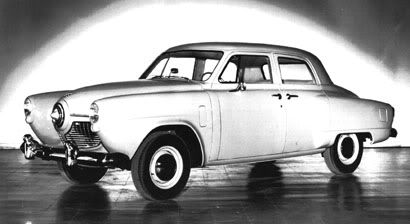
● Introduction: May 1946 for this generation of Studebaker cars, early 1950 for the Champion Custom. Construction: body on separate chassis. Engine: water-cooled inline six, 2.8-litre, 85 hp, mounted at the front. A high-compression version of this engine is available. Transmission: to the rear wheels through a three-speed manual gearbox. Three-speed automatic gearbox optional. Suspension: independent at the front, rigid axle at the rear. Brakes: hydraulic, to drums on all four wheels. Length: 502 cm. Top speed: n/a. Range: two-door three-passenger coupe, two-door five-passenger “Starlight” coupe, two-door sedan, four-door sedan.
Studebaker Champion DeLuxe
The intermediate trim among the Champion’s line, the DeLuxe sports chromed headlight rims.
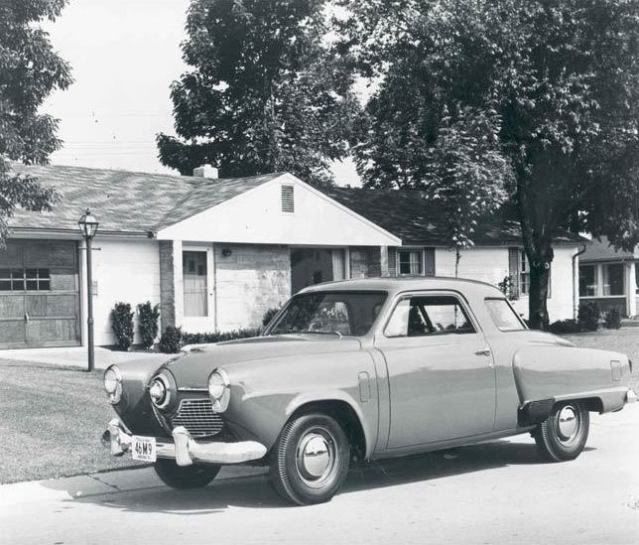
● Introduction: May 1946. Construction: body on separate chassis. Engine: water-cooled inline six, 2.8-litre, 85 hp, mounted at the front. A high-compression version of this engine is available. Transmission: to the rear wheels through a three-speed manual gearbox. Three-speed automatic gearbox optional. Suspension: independent at the front, rigid axle at the rear. Brakes: hydraulic, to drums on all four wheels. Length: 502 cm. Top speed: n/a. Range: two-door three-passenger coupe, two-door five-passenger “Starlight” coupe, two-door sedan, four-door sedan.
Studebaker Champion Regal
The Champion Regal receives stainless steel rocker panels, but otherwise remains rather similar to the DeLuxe. A convertible is exclusive to this trim.
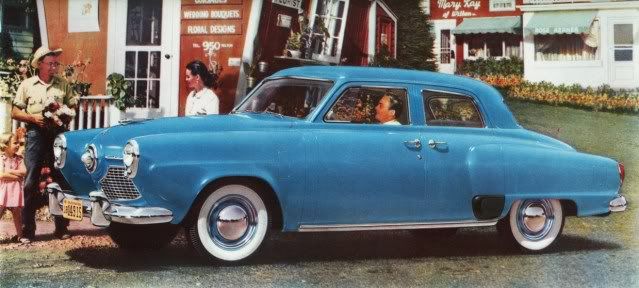
● Introduction: May 1946. Construction: body on separate chassis. Engine: water-cooled inline six, 2.8-litre, 85 hp, mounted at the front. A high-compression version of this engine is available. Transmission: to the rear wheels through a three-speed manual gearbox. Three-speed automatic gearbox optional. Suspension: independent at the front, rigid axle at the rear. Brakes: hydraulic, to drums on all four wheels. Length: 502 cm. Top speed: n/a. Range: two-door three-passenger coupe, two-door five-passenger “Starlight” coupe, two-door sedan, four-door sedan, two-door convertible coupe.
Studebaker Commander Regal
The Commander is Studebaker’s most expensive line since the President has been dropped from the company’s post-war range. This year, it loses its extended wheelbase but gains a V-8 engine and receives the Regal trim as standard.
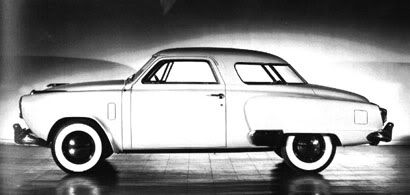
● Introduction: May 1946. Construction: body on separate chassis. Engine: water-cooled V-8, 3.8-litre, 120 hp, mounted at the front. Transmission: to the rear wheels through a three-speed manual gearbox. Three-speed automatic gearbox optional. Suspension: independent at the front, rigid axle at the rear. Brakes: hydraulic, to drums on all four wheels. Length: 502 cm. Top speed: 145 kph. Range: two-door five-passenger “Starlight” coupe, two-door sedan, four-door sedan. Note: a single Commander Regal two-door three-passenger business coupe is built, but this one-off is not officially part of Studebaker’s range.
Studebaker Commander State
The Commander State is Studebaker’s new plush V-8 model, which adds more chrome to the plainer Regal trim. The only Commander convertible this year is part of this line.
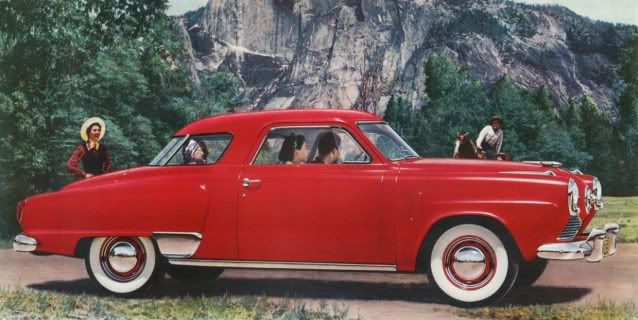
● Introduction: May 1946 for this generation of Studebaker cars, 1951 for the Commander State. Construction: body on separate chassis. Engine: water-cooled V-8, 3.8-litre, 120 hp, mounted at the front. Transmission: to the rear wheels through a three-speed manual gearbox. Three-speed automatic gearbox optional. Suspension: independent at the front, rigid axle at the rear. Brakes: hydraulic, to drums on all four wheels. Length: 502 cm. Top speed: 145 kph. Range: two-door five-passenger “Starlight” coupe, two-door sedan, four-door sedan, two-door convertible coupe.
Studebaker Commander Land Cruiser
Available only as a sedan, the Land Cruiser is a plush variant of the Commander which enjoys a chassis lengthened by ten centimetres, for the benefit of the passengers’ legroom.
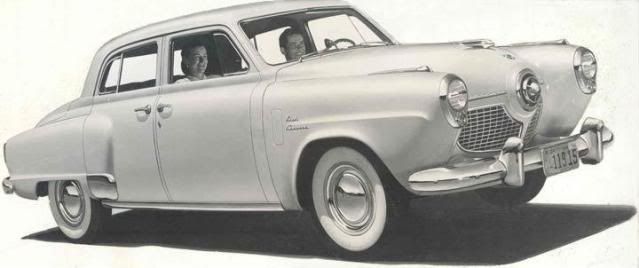
● Introduction: May 1946. Construction: body on separate chassis. Engine: water-cooled V-8, 3.8-litre, 120 hp, mounted at the front. Transmission: to the rear wheels through a three-speed manual gearbox. Three-speed automatic gearbox optional. Suspension: independent at the front, rigid axle at the rear. Brakes: hydraulic, to drums on all four wheels. Length: 512 cm. Top speed: 145 kph. Range: four-door sedan.
Any mistake you’ve just spotted? A detail to add? A suggestion? Don’t hesitate to leave a comment!
Click to jump to another model year of the same car: 1947 – 1948 – 1949 – 1950 – 1951 – 1952
Click here to return to a list of all Studebaker vehicles presented on this blog.
Click here to return to this blog’s initial post, featuring a list of all vehicles already presented.
Studebaker Champion Custom
The Champion Custom is a simplified version of Studebaker’s cheapest line, designed to compete directly with Chevrolet’s or Ford’s products. It can be easily recognized by its painted headlight and taillight rims.

● Introduction: May 1946 for this generation of Studebaker cars, early 1950 for the Champion Custom. Construction: body on separate chassis. Engine: water-cooled inline six, 2.8-litre, 85 hp, mounted at the front. A high-compression version of this engine is available. Transmission: to the rear wheels through a three-speed manual gearbox. Three-speed automatic gearbox optional. Suspension: independent at the front, rigid axle at the rear. Brakes: hydraulic, to drums on all four wheels. Length: 502 cm. Top speed: n/a. Range: two-door three-passenger coupe, two-door five-passenger “Starlight” coupe, two-door sedan, four-door sedan.
Studebaker Champion DeLuxe
The intermediate trim among the Champion’s line, the DeLuxe sports chromed headlight rims.

● Introduction: May 1946. Construction: body on separate chassis. Engine: water-cooled inline six, 2.8-litre, 85 hp, mounted at the front. A high-compression version of this engine is available. Transmission: to the rear wheels through a three-speed manual gearbox. Three-speed automatic gearbox optional. Suspension: independent at the front, rigid axle at the rear. Brakes: hydraulic, to drums on all four wheels. Length: 502 cm. Top speed: n/a. Range: two-door three-passenger coupe, two-door five-passenger “Starlight” coupe, two-door sedan, four-door sedan.
Studebaker Champion Regal
The Champion Regal receives stainless steel rocker panels, but otherwise remains rather similar to the DeLuxe. A convertible is exclusive to this trim.

● Introduction: May 1946. Construction: body on separate chassis. Engine: water-cooled inline six, 2.8-litre, 85 hp, mounted at the front. A high-compression version of this engine is available. Transmission: to the rear wheels through a three-speed manual gearbox. Three-speed automatic gearbox optional. Suspension: independent at the front, rigid axle at the rear. Brakes: hydraulic, to drums on all four wheels. Length: 502 cm. Top speed: n/a. Range: two-door three-passenger coupe, two-door five-passenger “Starlight” coupe, two-door sedan, four-door sedan, two-door convertible coupe.
Studebaker Commander Regal
The Commander is Studebaker’s most expensive line since the President has been dropped from the company’s post-war range. This year, it loses its extended wheelbase but gains a V-8 engine and receives the Regal trim as standard.

● Introduction: May 1946. Construction: body on separate chassis. Engine: water-cooled V-8, 3.8-litre, 120 hp, mounted at the front. Transmission: to the rear wheels through a three-speed manual gearbox. Three-speed automatic gearbox optional. Suspension: independent at the front, rigid axle at the rear. Brakes: hydraulic, to drums on all four wheels. Length: 502 cm. Top speed: 145 kph. Range: two-door five-passenger “Starlight” coupe, two-door sedan, four-door sedan. Note: a single Commander Regal two-door three-passenger business coupe is built, but this one-off is not officially part of Studebaker’s range.
Studebaker Commander State
The Commander State is Studebaker’s new plush V-8 model, which adds more chrome to the plainer Regal trim. The only Commander convertible this year is part of this line.

● Introduction: May 1946 for this generation of Studebaker cars, 1951 for the Commander State. Construction: body on separate chassis. Engine: water-cooled V-8, 3.8-litre, 120 hp, mounted at the front. Transmission: to the rear wheels through a three-speed manual gearbox. Three-speed automatic gearbox optional. Suspension: independent at the front, rigid axle at the rear. Brakes: hydraulic, to drums on all four wheels. Length: 502 cm. Top speed: 145 kph. Range: two-door five-passenger “Starlight” coupe, two-door sedan, four-door sedan, two-door convertible coupe.
Studebaker Commander Land Cruiser
Available only as a sedan, the Land Cruiser is a plush variant of the Commander which enjoys a chassis lengthened by ten centimetres, for the benefit of the passengers’ legroom.

● Introduction: May 1946. Construction: body on separate chassis. Engine: water-cooled V-8, 3.8-litre, 120 hp, mounted at the front. Transmission: to the rear wheels through a three-speed manual gearbox. Three-speed automatic gearbox optional. Suspension: independent at the front, rigid axle at the rear. Brakes: hydraulic, to drums on all four wheels. Length: 512 cm. Top speed: 145 kph. Range: four-door sedan.
Any mistake you’ve just spotted? A detail to add? A suggestion? Don’t hesitate to leave a comment!
Click to jump to another model year of the same car: 1947 – 1948 – 1949 – 1950 – 1951 – 1952
Click here to return to a list of all Studebaker vehicles presented on this blog.
Click here to return to this blog’s initial post, featuring a list of all vehicles already presented.
No comments:
Post a Comment